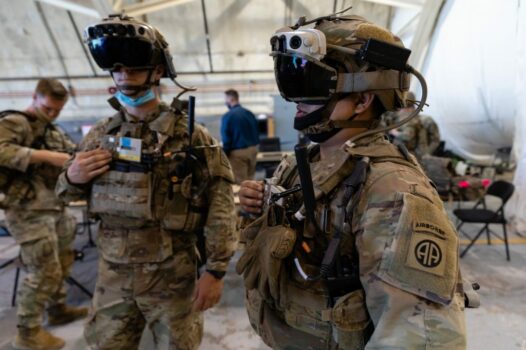
Remember those mixed reality combat goggles that Microsoft was building for the Army that made soldiers nauseous? (See our previous story here.) Well, they’re back.
Microsoft got its hands slapped and had to go back to the drawing board after reports came out last year that its new AR goggles were making soldiers literally sick to their stomachs. But it seems they’ve fixed the issues, and are ready for round two.
The Army just placed a new order for the Integrated Visual Augmentation System or IVAS goggles, Bloomberg reports.
Microsoft sent the Army some new prototype headsets this summer. The company apparently fixed the issues that caused headaches, nausea and pain.
The Army spokesperson said the new headsets showed “improvements in reliability, low light sensor performance, and form factor.”
I’m sure Microsoft was sweating bullets about this contract, since its consumer AR efforts seem to be dying on the vine. Apple has been grabbing all the hype with its upcoming mixed reality headset — but at $3,500 a pop, I don’t know how much traction those headsets are going to get, either. Which just leaves Meta and the Quest 2.
Meanwhile, Microsoft laid off a bunch of the HoloLens team earlier this year.
The next steps for IVAS include adding in cloud computing, the Army Times reports. This will let soldiers download apps for specific mission needs.
The Army wants to avoid overloading IVAS by offloading apps to the cloud instead of the device. During testing, soldiers used the goggles for assault planning, mission practice, targeting, and more.
IVAS lets them ditch the sand table to quickly scout and rehearse missions virtually.
Rather than an MRE-box sand table, a unit could virtually “see” the terrain in their heads-up display and rehearse a mission in their patrol base before leaving the wire,” Brig. Gen. Christopher Schneider told Army Times.
“Now we have to make this system producible and affordable,” he added.
Earlier issues around night vision, size, and weight are getting fixed bit by bit. The goal is to nail down cost and manufacturing in 18 months.
If all goes well, IVAS could start hitting units by 2025. Of course, that’s assuming the cloud tech actually works as advertised. And that Congress keeps funding the project.
How it started
Microsoft started working with the Army in 2018 on mixed reality headsets using its HoloLens tech. The goal was to help soldiers train, plan missions and operate better in the field, the company said in a long article about the project two years ago.
IVAS has night vision, heat sensors, 3D mapping and other HoloLens features. It’s meant to give soldiers more awareness by layering digital info onto the real world, the company said.
To get input, Microsoft engineers did mock bootcamps in 2019, where they learned skills like navigating at night. This helped them design IVAS to handle tough conditions soldiers face.
After soldiers tested IVAS for around 80,000 hours by early 2021, Microsoft had a headset ready for combat use.
I’m not sure why they missed the whole nausea thing the first time around. Maybe the engineers had been using the headset so much themselves, during the whole development process, that they were used to it? Or it was so much better than the early iterations, that the nausea didn’t even register as a problem any more?
- Kitely Mega Worlds on sale for $90 per month - July 19, 2024
- OpenSim regions up, actives down with summer heat - July 15, 2024
- People think AIs are conscious. What could this mean for bots in OpenSim? - July 12, 2024
